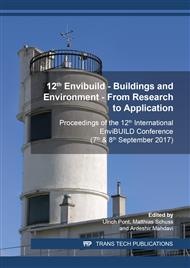[1]
International Energy Agency, Total Energy Use in Buildings Analysis and Evaluation Methods,,, International Energy Agency, (2013).
Google Scholar
[2]
J. M. Cullen, J. M. Allwood and E. H. Borgstein, Reducing Energy Demand: What Are the Practical Limits?,, Environmental Science & Technology, pp.1711-1718, 12 01 (2011).
DOI: 10.1021/es102641n
Google Scholar
[3]
K. Oung, Energy Management in Business - Manager's Guide to Maximising and Sustaining Energy Reduction, Farnham: Gower Publishing Ltd., 2013, p.2 ff.
Google Scholar
[4]
K. Menzel and E. Morre, Computer Aided Facilities Management (Lecture Material), Cork: University College Cork, (2015).
Google Scholar
[5]
GEFMA 124-1, Energiemanagement: Grundlagen, Leistungsbild, Bonn: Deutscher Verband für Facility Management e.V, (2009).
Google Scholar
[6]
J. O`Donnell, M. Keane, E. Morrissey and V. Bazjanac, Scenario modelling: A holistic environmental and energy management method for building operation optimisation,, Energy and Buildings, pp.147-157, 15 10 (2012).
DOI: 10.1016/j.enbuild.2012.10.060
Google Scholar
[7]
M. Di Piazza, G. La Tona, A. Di Piazza and M. Luna, A two-stage Energy Managemenmt System for smart buildings reducing the impact of demand uncertainty,, Energy and Building 139, pp.1-9, 02 04 (2017).
DOI: 10.1016/j.enbuild.2017.01.003
Google Scholar
[8]
ISO 50001, Energy management systems – Requirements with guidance for use, Geneva: International Standards Organisation, (2011).
Google Scholar
[9]
VDI 4602 part 1, Energiemanagement (energy management), Düsseldorf, Germany: Verein Deutscher Ingenieure e.V., (2007).
Google Scholar
[10]
L. G. Mkhaimer, M. Arafeh and A. H. Sakhrieh, Effective implementation of ISO 50001 energy management system: Applying Lean Six Sigma approach,, International Journal of Engineering Business Managment Vol 9, pp.1-12, 11 02 (2017).
DOI: 10.1177/1847979017698712
Google Scholar
[11]
TÜV Akademie Nord, Energiemanagement Beauftragter (TÜV) Teil 1, Hannover, Germany: Technischer Überwachungsverein, (2015).
Google Scholar
[12]
B. Gopalakrishnan, K. Ramamoorthy, E. Crowe, S. Chaudhari and H. Latif, A structured approach for facilitating the implementation of ISO 50001 standard in the manufacturing sector,, Sustainable Energy Technologies and Assessments, pp.154-165, 01 09 (2014).
DOI: 10.1016/j.seta.2014.04.006
Google Scholar
[13]
European Parliament and Council of EU, energy efficiency directive," 2012. [Online]. Available: http://eur-lex.europa.eu/legal-content/en/TXT/,uri=celex%3A32012L0027. [Accessed 29 04 2017].
Google Scholar
[14]
DIN EN 16247, Energy audits - Part 1: General requirements, Berlin: Beuth Verlag, (2012).
Google Scholar
[15]
ISO 14001, Anforderungen an Umweltmanagement Systeme, Geneva: International Standard Organisation, (2015).
Google Scholar
[16]
European Commission, Eco- Management and Audit Scheme,, 22 07 2016. [Online]. Available: http://ec.europa.eu/environment/emas/index_en.htm. [Accessed 14 04 2017].
Google Scholar
[17]
S. German Government and Parliament, Stromnetzzugangsverordnung (in German),, 25 07 2005. [Online].
Google Scholar
[18]
A. Colmenar-Santos, L. N. Terán de Lober, D. Borge-Diez and M. Castro-Gil, Solutions to reduce energy consumption in the management of large buidlings,, Energy and buildings, pp.66-77, 02 October (2012).
DOI: 10.1016/j.enbuild.2012.10.004
Google Scholar
[19]
VDI 2067, Wirtschaftlichkeit gebäudetechnischer Anlagen, Düsseldorf, Germany: Verein Deutscher Ingenieure e.V., (2000).
Google Scholar
[20]
B. Jovanivic and J. Filipovic, ISO 50001 standard based energy management maturity model- proposal and validation in industry,, Jornal of Cleaner Production, pp.2744-2755, 2319 (2015).
DOI: 10.1016/j.jclepro.2015.10.023
Google Scholar
[21]
European Union, Buildings,, 2017. [Online]. Available: http://ec.europa.eu/energy/en/topics/ energy-efficiency/buildings. [Accessed 25 03 2017].
Google Scholar


